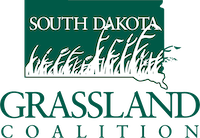By Kate Rasmussen
Jim Faulstich, Chair of the South Dakota Grass-land Coalition, began his work on the board in 2000 after experiencing the value of grassland on his own operation. From migratory bird habitat to prime hunting ground, the benefits of Jim’s land stewardship stream from his place like tributaries. Jim hasn’t always run a business that can be described with labels like “wildlife-friendly” and “conservation-focused.” He adopted his land ethic not to jump on a marketing bandwagon but as a means of holding onto the family business.
The tough economic climate of the 80’s pushed Jim to take a critical look at the way he ran his place: “It’s easy to spend a lot of energy trying to put a square peg in a round hole. We were putting up feed and hauling it out, spraying chemicals on the ground, pouring for flies, calving in April.” In the name of efficiency, Jim cut costs by shifting his focus toward supporting the natural resources he had available.
One of his first steps toward focusing on the land was to get an outside perspective: “We hired a range consultant who pointed out the diversity we had lost.” Since then, Jim has made plant and animal diversity a major priority. He planted marginal crop ground back to native grassland and keeps his inputs low by letting the cattle do the harvesting. “We’ve improved our land by rotating the cattle from pasture to pasture and figuring out the best timing for grazing. We started calving later and bringing in less feed. Our cropland is 100% no-till and we plant full season cover crops that the cattle graze over the winter.” Among many others, these changes helped make Jim’s place a lower stress, higher performance operation for both the cattle and the land.
I visited the Faulstich family operation over the summer where Jim’s visionary ideals are hard at work. His bird dogs piled in the back of the pickup and we set off on a tour of Day Break Ranch. Jim pointed out grasshopper sparrows and bobolink as we passed stretches of native grasses rarely seen in the Corn Belt. He doesn’t hire range consultants anymore. Instead, he uses the winged versions: “If the birds and pollinators aren’t doing well, we’re doing something wrong. Not enough producers pay attention to pollinators.”
Soon after making major land management changes, his place began to team with wildlife. He noticed increasing numbers of endangered songbirds making a home in his pastures along with migratory birds and white tail deer. This welcome unintended consequence opened up the opportunity to add a hunting enterprise to the ranch, giving his daughter and son-in-law the chance to come back to the family business.
“Diversity,” Jim said “is the key, whether it’s enterprises or grass.” Hunters come to Day Break Ranch for the deer and game birds, but also for the opportunity to be a part of the type of landscape their grandfathers hunted on. “It blows my mind how much these guys appreciate the land and wildlife and quiet,” he said as we approached a grove of trees, “and it all fits with our management philosophy.” Jim slowed to a stop and pointed out a memorial stone near the base of a tree stand. The name across the stone belonged to a devoted hunter and marks his favorite spot, the place his family spread his ashes when he passed.
Jim’s first hand experience with the far reaching value of land stewardship has motivated his dedication to the South Dakota Grassland Coalition: “I feel obligated to do what I can for grasslands in this state.” The organization has expanded significantly in the past several years, growing in membership and catching the attention of organizations like World Wildlife Fund and The Audubon Society. Jim doesn’t seem to mind taking time away from the ranch to be on the board of the Grassland Coalition: “Talk about a dedicated bunch, these guys are it. It’s all volunteer work. They’re dedicated to the grasslands because they’re all producers.” In reference to his favorite part of being on the board, Jim said he felt “getting to work with all these people that are innovative and willing to buckle down and find solutions to problems on a regular basis is almost as gratifying as getting things done.”
Diversity and effective education are essential to the survival of the Great Plains. The Grassland Coalition has created a place to find guidance and information on farming and ranching in the Great Plains, run by producers dedicated to sharing what they’ve learned through their own experiences. Jim believes that the SDGC message is just as important to share with producers as it is for consumers: “Unless you don’t plan on eating, drinking, or breathing tomorrow, it’s important to understand what’s happening on the landscape.”
